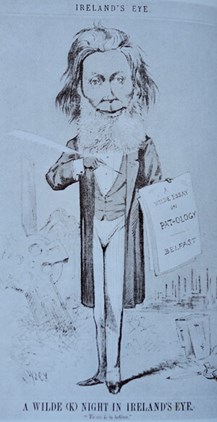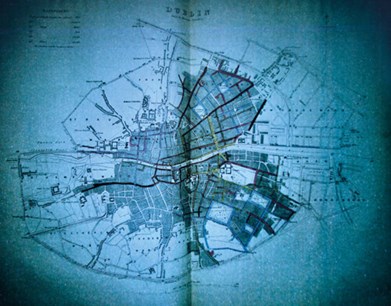William Wilde (father of Oscar) was renowned as an otologist, but less well known for his work in epidemiology. The bedrock of the modern discipline of public health is good data collection, and we hear from our good friend, Ray Clarke, about William Wilde’s invaluable contribution.
“In the morning they were both found dead.
Of cold. Of hunger. Of the toxins of a whole history.
But her feet were held against his breast bone.
The last heat of his flesh was his last gift to her”
‘Quarantine’, 2001. Eavan Boland (1944-2020).
Sir William Wilde (1815-1876) is well known to otologists for his pioneering work in establishing the surgery of ear disease on a scientific footing at a time when quacks, charlatans and faith-healers were very much to the fore.
His 1853 Aural Surgery [1], the first textbook of otology, quickly became the standard for the teaching of the then fledgling discipline throughout Europe and the USA. A gifted Victorian polymath, Wilde was a celebrated travel writer, archaeologist, and medical editor. Less well known is Wilde’s contribution to epidemiology; his role as Census Commissioner in Ireland in the 1840s and ‘50s earned him his knighthood. The Lord Lieutenant Lord Carlisle’s citation lauded Wilde for “services you have rendered to Statistical Science, especially in connection with the Irish Census” (Figure 1).

Figure 1. Caricature of Wilde on the occasion of his knighthood, 1864, from a satirical magazine.
Wilde’s two censuses, 1841 and particularly 1851, became models of good practice throughout Europe and the USA. His ‘death tables’ became the standard method for recording mortality data as the specialty of Public Health developed. Some of his findings made uncomfortable reading for the Government in Westminster - in the 1841 report he showed clearly that infectious diseases such as typhoid and cholera ‘clustered’ around areas of poor sanitation (Figure 2), thus helping to mobilise the reluctant Dublin city fathers to improve the water supply and the means for disposal of effluent.
“Wilde was meticulous in his collection and presentation of data, and in his ability to sift through large swathes of figures to draw important inferences”

Figure 2. Map of Dublin in Wilde’s own hand, from the 1841 census. Shading depicts differences in mortality rates by district.
Wilde was meticulous in his collection and presentation of data, and in his ability to sift through large swathes of figures to draw important inferences. During a sojourn in the Algemeine Krankenhaus in Vienna as a young man, he had been greatly impressed by the enlightened version of ‘socialised’ state-funded medical care that held sway throughout much of the Austro-Hungarian Empire. Wilde noted the high incidence of puerperal sepsis and maternal death in mothers who were cared for by attendants - mainly medical students - with poor hand hygiene long before Semmelweis made these observations. He linked high infant mortality figures with poor nurse-to-patient ratios in the foundling hospital in Vienna. By meticulous analysis of infant death records and by correlating them with diagnostic data, he deduced that the hospital mortality from infant gastro-enteritis was 73%.
“In a macabre parallel with the current pandemic, death rates in carers were especially high due to infectious ‘famine fever’”
This was at a time when disease-specific mortality was an unknown concept. His observations that some infections in the newborn could be easily transmitted to the midwife, sparing the mother, predated the science of immunology, and his analysis of the inheritance patterns of some forms of deafness through the male line, and the higher incidence of deafness in the children of consanguineous parents were made at a time when sex-linked inheritance and the notion of recessive genes were completely unknown. He was a powerful advocate for the ‘cowpox’ and helped expose unscrupulous ‘quacks’ who were using adulterated and dangerous infected material to claim fees for ‘vaccination’ when smallpox was still a significant killer. The idea of a national census was very much in its infancy when Wilde was given the task.
There was no formal register of births or deaths. Questionnaires were filled in by poorly-trained ‘constables’, chosen in large measure for their loyalty to the local landlords, with little or no medical input. Wilde set about changing that by securing the support of his medical colleagues to gather the data. He ensured good training and good pay and conditions for Census officers, and designed the questionnaires himself. He overcame suspicions by enlisting the support of the Catholic clergy, who assured their flock that the Census would not be followed by a biblical disaster, and that it was the duty of every ‘head of household’ to cooperate.
“It is sobering to remember that good data collection and meticulous and honest reporting of facts, uncomfortable though they are, form the foundations of medical epidemiology”
Wilde’s tenure coincided with the tumultuous years of the potato famine [2,3]. Fever hospitals, workhouses and mass graves were quickly built to accommodate the huge numbers of dead and dying. His 1851 report covered the darkest period, 1847 (‘Black 47’) and ran to over 4500 pages in 20 foolscap volumes. Over 700 pages were written in his own hand. He introduced the then novel concept of recording tables of death by age, occupation, disease and place of residence. Mortality was especially high in the workhouses, prisons, fever hospitals and ‘lunatic asylums’, and death was frequently not from starvation but from the infectious diseases that flourished in a population rendered helpless by poverty, overcrowding and malnutrition. In a macabre parallel with the current pandemic, death rates in carers were especially high due to infectious ‘famine fever’. Workhouse superintendents and staff died in their scores; a quarter of the ‘dispensary doctors’ who tended the poor perished. Wilde reproduced many eye-witness accounts of these brave souls in full:
“Dr. Curran thus describes some scenes of horror probably never equalled in modern times in any capital city. At the gate, leading to the temporary fever hospital, were men, women, and children, lying along the pathway, and in the gutter, awaiting their turn to be admitted. Some were stretched at full length, with their faces exposed to the full glare of the sun, their mouths open, and their black and parched tongues, and encrusted teeth, visible even from a distance. Some women had children at the breast, who lay beside them in silence and apparent exhaustion, the fountain of their life being dried up, whilst in the centre of the road stood a cart containing a whole family, who had been smitten down together by the terrible typhus, and had been brought there by the charity of a neighbour. Inside the hospital enclosure was a small open shed, in which were thirty-five human beings, heaped indiscriminately on a little straw thrown on the ground. Several had been thus for days.”
Wilde understood that terrifying though the figures were, personalised anecdotes conveyed the full horror, something many of us have learned from the current pandemic in which we have lost colleagues and friends. Tragedy touched his own life in 1867 when his beloved 10-year-old daughter, Isola, died of a fever. The event was a life-long source of sadness for her brother, Oscar. A lock of Isola’s hair, carefully mounted and labelled, was found among his possessions when he died in Paris in 1900. In these troubled times, when our screens are bombarded daily with graphs, tables, and spreadsheets, it is sobering to remember that good data collection and meticulous and honest reporting of facts, uncomfortable though they are, form the foundations of medical epidemiology.
References
1. Wilde W. Practical Observations on Aural Surgery and the Nature and Treatment of Diseases of the Ear. London, UK; John Churchill; 1853.
2. Wilson TG. Victorian Doctor: being the life of Sir William Wilde. London, UK; Methuen & Co Ltd; 1942.
3. de Vere White T. The Parents of Oscar Wilde: Sir William and Lady Wilde. London, UK; Hodder and Stoughton; 1967.




